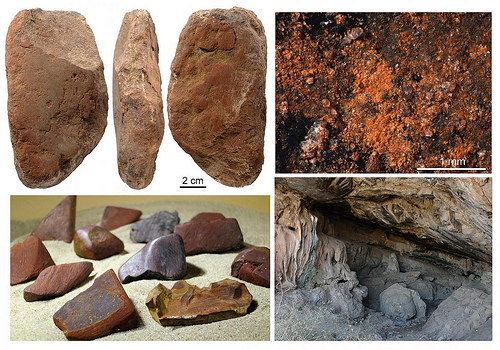
PLOS—Middle Stone Age humans in East Africa may have employed varied techniques to process ochre for functional and symbolic uses, according to a study* published November 2, 2016 in the open-access journal PLOS ONE by Daniela Rosso from the University of Bordeaux, France, and colleagues.
Ochre fragments-which are rocks containing iron oxides, red or yellow in color-have often been found at Middle Stone Age sites and have played a role in shaping the cultures of early African Homo sapiens. Some researchers suggest that ochre was used for utilitarian purposes, for example in glue to adhere handles to tools, whilst others believe that the pigment was used for symbolic purposes, such as body painting or creating meaningful patterns. However, few ochre processing tools have been studied in detail to understand how this material was processed.
The authors of the present study used microscopy, spectroscopy and X-ray techniques to analyze 21 ochre-processing tools and two ochre-stained artifacts from the Porc-Epic Cave, a 40,000-year-old Middle Stone Age site in Ethiopia.
The researchers found that the tools appeared to have been used to process different types of iron-rich rocks. A range of stone types were used as grindstones, producing ochre powder of different color and coarseness, likely employed to suit different functions, revealing a high degree of behavioral complexity. For example, finer powders would be most suitable for body painting, whereas coarser ochre would be suitable for functional uses. One round stone appeared to have been painted or used as a stamp to apply pigment powder to different surfaces. The authors note that this is the first Paleolithic site to provide such comprehensive documentation of ochre processing techniques.
_____________________________________
Top left: tool used to grind ochre from the Middle Stone Age levels of Porc-Epic Cave, Dire Dawa, Ethiopia; Top right: residues of ochre on the same object; Bottom left: modified ochre lumps from the same levels; Bottom right: photo of the cave. Courtesy D.E. Rosso and F. d’Errico
_________________________________________________
“This study analyses the largest collection of such tools, found at Porc-Epic Cave, Dire Dawa, Ethiopia, in levels dated at c. 40,000 years ago,” says Rosso. “Ochre processing at Porc-Epic Cave reflects a high degree of behavioral complexity, and represents ochre use that was probably devoted to a variety of functions.”
Source: PLOS press release
If you liked this article, see the premium article in Popular Archaeology about the role of ochre in human evolution.
__________________________________________________
*Rosso DE, Pitarch Martí A, d’Errico F (2016) Middle Stone Age Ochre Processing and Behavioural Complexity in the Horn of Africa: Evidence from Porc-Epic Cave, Dire Dawa, Ethiopia. PLoS ONE 11(11): e0164793. doi:10.1371/journal.pone.0164793
__________________________________________________

______________________________________________
Travel and learn with Far Horizons.
____________________________________________
This richly illustrated issue includes the following stories: Recent findings shedding new light on the whereabouts of the remains of Philip of Macedon, father of Alexander the Great; how an archaeologist-sculptor is bringing bones of the dead back to life; archaeologists uncovering town life at the dawn of civilization; an exclusive interview with internationally acclaimed archaeologist James M. Adovasio about what makes the Meadowcroft Rockshelter prominent in the ongoing search for the first Americans; what archaeologists are finding at the site of the ancient city of Gath, the home town of the biblical Philistine giant, Goliath; and how scientists are redrawing the picture of human evolution in Europe. Find it on Amazon.com.








